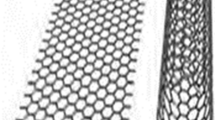Abstract
Carbon Nanotubes (CNTs) are of significant research interest due to their significant electrical, mechanical, electro-mechanical and thermal properties. This enables CNT to be used in advanced bio-medical, electronics and materials technological applications. CNTs can be synthesized by various methods such as Arc-discharge, Chemical Vapor Deposition (CVD), Laser ablation etc. Still challenge exists when it comes to the yield. In general CNTs are commercially synthesized by Arc-discharge and CVD techniques. In both the cases the defect intensity differs according to the atmosphere which prevails in the production chamber. In the case of CVD the defect intensity is mainly due to pentagons of carbon, which cause curved faces whereas in the case of arc discharge, broken bonds can result at the surfaces.
In general, the production of CNTs requires the presence of a controlled atmosphere inside the reaction chamber. Recent research has shown that CNTs can also be produced in open atmosphere but with a significant reduction in the yield. In the present work, a jet of nitrogen gas is applied between the arcing interfaces. As a consequence there is a significant change in the yield and defect density. Characterization techniques such as XRD, FEG-SEM, TEM and Raman spectroscopy confirm the same.
Similar content being viewed by others
References
Iijima S, Nature, 354 (1991) 56.
Noriaki Hamada and Shin-ichi Sawada Atsushi Oshiyama, Phys. Rev. Lett., 68 (1992) 1579.
Seunghun Hong and Sung Myung, Nature Nanotech., 2 (2007) 207.
Treacy M M J, Ebbesen T W and Gibson J M, Nature 381 (1996) 678.
Journet C, Maser W K, Bernier P, Loiseau A, Lamydela Chapelle M, Lefrant S, Deniard P, Leek R and Fischer J E, Nature, 388 (1997) 756.
K. Shimotani, K. Anazawa, H. Watanabe, M. Shimizu, Appl. Phys. A 73 (2001) 451.
Cui S, Scharff P, Siegmund C, Spiess L, Romanus H, Schawohl J, Risch K, Schneider D and Klotzer S, Carbon, 411 (2002) 1645.
Ravi Joshi, Jörg Engstler, Kesavan Nair P, Prathap Haridoss and Jörg J. Schneider, Diamond & Related Materials, 17 (2008) 913.
Ajayan P M, Ebbesen T W, Ichihashi T, Iijima S, Tanigaki K, and Hiura H, Nature 362 (1993) 522.
Paladugu M, Maneesh K, Nair P K and Haridoss P, J. Nanosci. Nanotechnol., 5 (2005) 747.
Eugene G. Gamaly and Thomas W. Ebbesen, Mechanism of carbon nanotubes formation in the arc discharge, Phys. Rev. B 52 (1995) 2083.
Lambin P, Loiseau A, Culot C and Biro L, Carbon 40 (2002) 1635.
Hiura H, Ebbesen T, Tanigaki K and Takahashi H, Chem. Phys. Lett., 202 (1993) 509.
John D. Saxby, Peter ChatfieldS, Andrew J. Palmisano, Anthony M. Vassallo, Michael A. Wilson and Louis S.K. Pang, Thermogravimetric Analysis of Buckminsterfullerene and Related Materials in Air. J. Phys. Chem. 96 (1992) 17.
Louis S.K. Pang, John D. Saxby and Peter Chatfield S, Thermogravimetric Analysis of Carbon Nanotubes and Nanoparticles, J. Phys. Chem. 97 (1993) 6941.
Ajayan P M, Ebbesen T W, Ichihashi T, Iijima S, Tanigaki K and Hiura H, Opening of carbon nanotubes by oxygen and implication for filling, Nature 362 (1993) 522.
Large scale synthesis of single-wall carbon nanotubes by arcdischarge method, Journal of Physics and Chemistry of Solids, 61 (2000) 1031.
Author information
Authors and Affiliations
Corresponding author
Rights and permissions
About this article
Cite this article
Berkmans, A.J., Haridoss, P. High yield formation of carbon nanotubes using arc discharge assisted with a nitrogen jet. Trans Indian Inst Met 64, 137 (2011). https://doi.org/10.1007/s12666-011-0027-3
Received:
Revised:
Accepted:
Published:
DOI: https://doi.org/10.1007/s12666-011-0027-3




